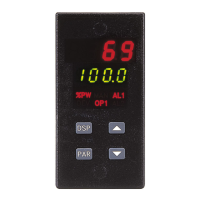EMC INSTALLATION GUIDELINES
Although this unit is designed with a high degree of immunity to
ElectroMagneticInterference (EMI),proper installationand wiringmethods
must be followed to ensure compatibility in each application. The type of
electrical noise, source or coupling method into the unit may be different for
various installations. In extremely high EMI environments, additional
measuresmay be needed. Theunit becomes more immune to EMIwith fewer
I/O connections. Cable length, routing and shield termination are very
importantandcan meanthedifference betweenasuccessful oratroublesome
installation. Listed below are some EMC guidelines for successful
installation in an industrial environment.
1. The unit should be mounted in a metal enclosure, which is properly
connected to protective earth.
2. Use shielded (screened) cables for all Signal and Control inputs. The
shield (screen) pigtailconnection shouldbe madeasshortaspossible. The
connection point for the shield depends somewhat upon the application.
Listed below are the recommended methods of connecting the shield, in
order of their effectiveness.
a. Connect the shield only at the panel where the unit is mounted to earth
ground (protective earth).
b. Connect the shield to earth ground at both ends of the cable, usually
when the noise source frequency is above 1 MHz.
c.Connectthe shieldtocommonof theunitandleavethe otherendofthe
shield unconnected and insulated from earth ground.
3.Never runSignalor Controlcablesin thesameconduit orracewaywith AC
power lines, conductors feeding motors, solenoids, SCR controls, and
heaters, etc. The cables should be run in metal conduit that is properly
grounded. This is especially useful in applications where cable runs are
long and portable two-way radios are used in close proximity or if the
installation is near a commercial radio transmitter.
4. Signal or Control cables within an enclosure should be routed as far away
as possible from contactors, control relays, transformers, and other noisy
components.
5. Inextremely high EMIenvironments, theuse of external EMIsuppression
devices, such as ferrite suppression cores, is effective. Install them on
Signal and Control cables as close to the unit as possible. Loop the cable
through the core several times or use multiple cores o n each cable for
additional protection. Install line f ilters on the power input cable to the
unit to suppress power line interference. Install themnear the power entry
point of the enclosure. The following EMI suppression devices (or
equivalent) are recommended:
Ferrite Suppression Cores for signal and control cables:
Fair-Rite # 0443167251 (RLC #FCOR0000)
TDK # ZCAT3035-1330A
Steward #28B2029-0A0
Line Filters for input power cables:
Schaffner # FN610-1/07 (RLC #LFIL0000)
Schaffner # FN670-1.8/07
Corcom #1VR3
Note: Reference manufacturer’s instructions when installing a line filter.
6. Long cable runs aremore susceptible to EMI pickup than short cableruns.
Therefore, keep cable runs as short as possible.
7. Switching of inductive loads produces high EMI. Use o f snubbers across
inductive loads suppresses EMI.
Snubbers:
RLC #SNUB0000
Wiring Connections
After the unit has been mechanically mounted, it is ready to be wired. All
conductors should meet voltage and current ratings for each terminal. Also
cabling should conform to appropriate standards of good installation, local
codesand regulations.It isrecommended thatpowersupplied to theunit(AC
or DC) be protected by a fuse or circuit breaker.
All wiring connections are made on a fixed terminal block. When wiring
the unit,use thenumberson thelabelto identifythe positionnumber withthe
proper function.Strip the wire, leavingapproximately 1/4"(6 mm)bare wire
exposed (stranded wires should be tinned with solder). Insert the wire into
the terminal and tighten the screw until the wire is clamped tightly. Each
terminalcanaccept upto two,18-gaugewires. Wireeach terminalblock inth i s

